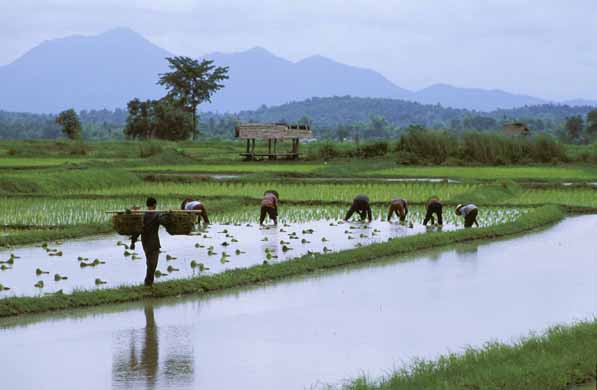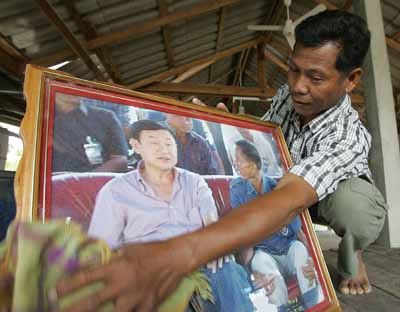A Poor Excuse?

Anti-government slogans fail to resonate in a typical northern Thai village.
International media coverage of last month’s Bangkok bloodshed often reduced the crisis to a struggle between Thailand’s “rural poor” and the country’s “elite.”
The privileged upper tenth of Thailand’s population of 62 million, who own more than 30 percent of the country’s wealth, are easy enough to identify because of the high-profile emblems of their materialistic clout— the glittering shopping malls, for instance, that were looted and set on fire by rampaging Redshirts.
 |
| Portraits of ousted premier thaksin Shinawatra are a common sight in homes in the Redshirt heartland. |
In regional comparisons based on per capita disposable income, Thailand is a relatively wealthy country, ahead of Indonesia, Vietnam, Cambodia, Laos—and far richer, of course, than Burma.
When the gap between rich and poor is measured, however, Thailand’s record is not so good.
According to a United Nations study, “poverty in Thailand is not so much a problem of an increasing number of families being unable to provide for their most basic needs, as it is a problem of the huge difference in income between the upper 30 percent and the rest of the population.”
This privileged 30 percent enjoys more than 80 percent of the country’s wealth—an undeniable injustice that is widely blamed for the anger that ignited the Redshirts, and yet largely the result of dynamic economic forces that even their renegade hero, ousted Prime Minister Thaksin Shinawatra, was unable to control.
For many outsiders, Thailand is a country of paradoxes. One of these is the huge popularity commanded by Thaksin, who is accused by his enemies of bankrolling the Redshirts in a bid to bring down the current government and pave the way for his unchallenged return from exile and the recovery of his seized assets.
Thaksin, his family and their business cronies were the country’s most famous representatives of the wealthy “elite” so hated by the very people who now declared themselves willing to die for the Redshirt cause.
“Ah, yes, he’s wealthy,” I was told by a northern Thailand villager. “But Thaksin was really one of us. He gave us hope, and he gave us money.”
So why, Thaksin’s critics ask, was hope so absent after five years of Thaksin’s premiership, from 2001 until his downfall in 2006? Why were so many villages worse off? And what happened to the money that he undeniably pumped into rural economies?
By the time Thaksin took office after a general election in 2001, the proportion of Thailand’s population classed as “poor” had dropped in 40 years from 57 percent to around 12 percent. A determined effort to push the national poverty level below 10 percent was one of the priorities of the 1997 Constitution.
Another main aim of the Constitution, and adopted by the present government headed by Abhisit Vejjajiva, was to work for greater decentralization, shifting more responsibility for local government in rural regions away from Bangkok and its cumbersome bureaucracy.
Until the late 1990s, the foundations of Thailand’s system of local government hadn’t changed greatly in 100 years. There was a semblance of democracy, with most essential services provided by elected district councils. But the councils are ultimately answerable to provincial authorities ruled by governors nominated by the central government—an arrangement that critics say is prone to cronyism and corruption.
In 1999, the government enacted a Decentralization Plan and Procedures Act intended to give local councils greater financial autonomy by increasing their share of the national budget to 35 percent by the end of 2006. Thaksin’s government failed dismally to meet that target.
Instead, Thaksin launched his famous Village and Urban Revolving Fund, handing out 1 million baht (US $30,000) to each of Thailand’s 74,000 villages and 4,500 towns, with the ostensible purpose of promoting business ideas that would generate cash and jobs.
Thaksin’s scheme was immensely popular and solidified his rural support base. In most cases, the money was distributed equitably on a revolving credit basis, recycling repaid loans.
The scheme lacked suitable supervision, however, and frequently led to bitter feuding over how best to distribute and invest the money.
1 | 2 next page »
|
||
|
||
